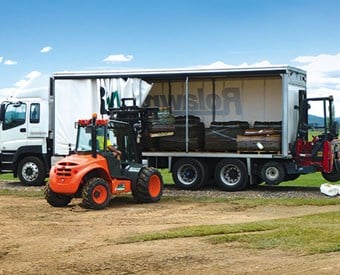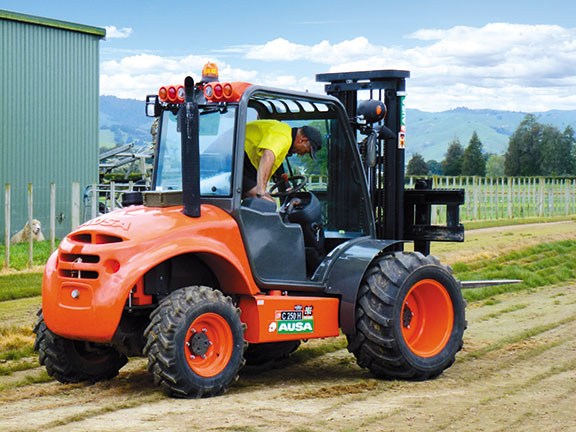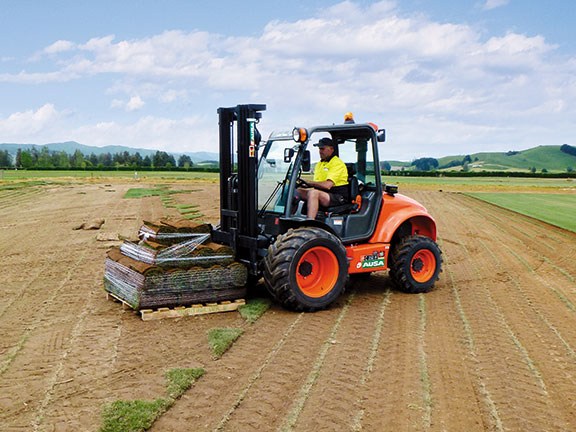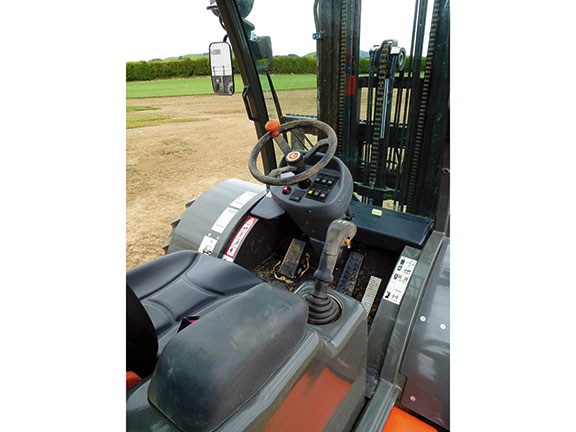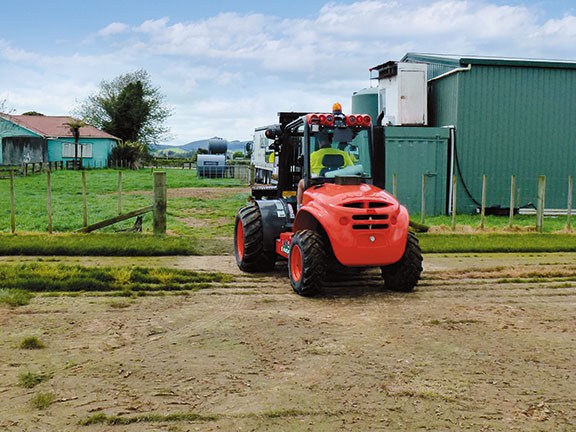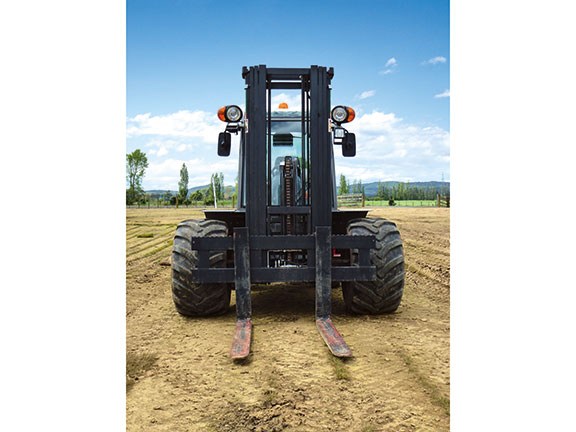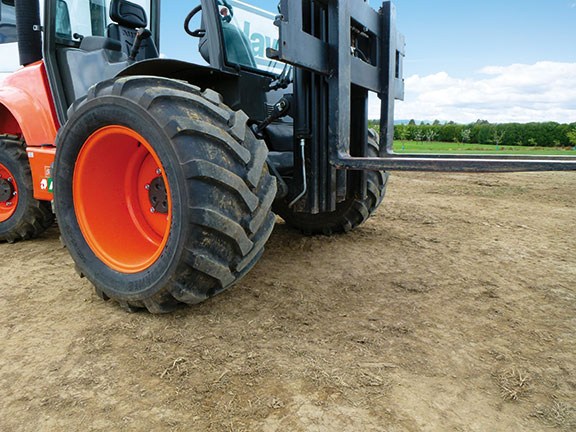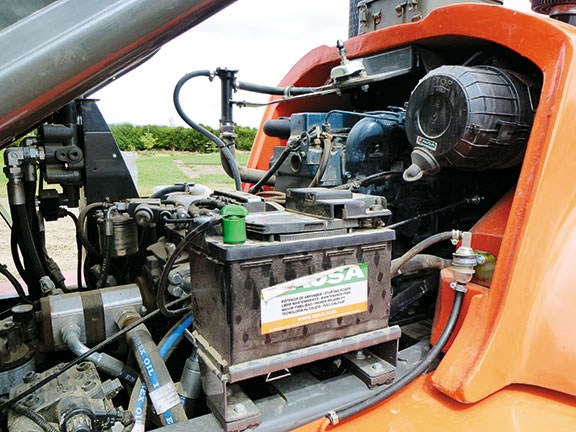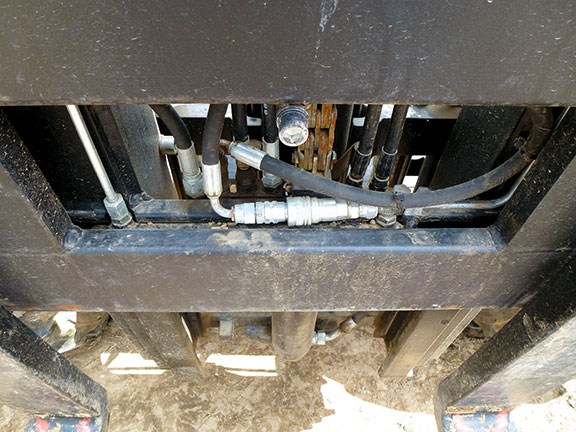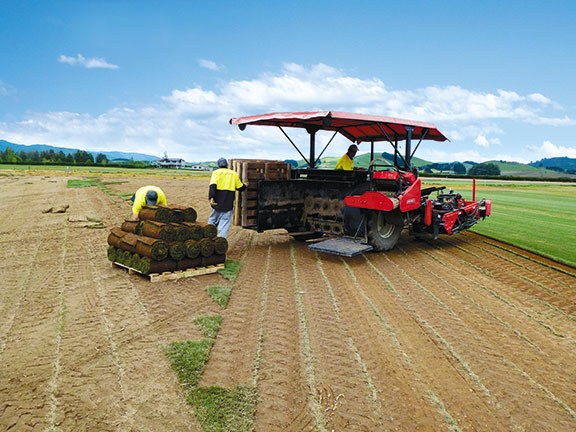The AUSA C 250H rough terrain forklift offers more than your average forklift. In fact, as Brent Lilley, discovers it comes into its own in rough and testing conditions.
I must admit, I was a little sceptical about the relevance of this rough terrain forklift to our readers, but my doubts were quickly assuaged when I saw the AUSA C 250H rough terrain forklift in action on a large turf farm.
Rolawn, a company operating a large turf farm, recently took ownership of a new AUSA forklift, making it the ideal company and situation in which to test it out. Rolawn grows several different varieties of grass, such as fescue, rye and kikuyu.
The turf is cut and sold directly to landscapers and Rolawn prides itself on providing a consistently high quality ready-to-lay lawn. This is not an easy task, given once cut the turf has a fairly limited lifespan. This is why Rolawn needs an efficient and reliable system to get the turf from its property to the end user, in the best possible condition.
The basic process is this: the turf is cut to order from the field with a specialised machine that cuts and rolls the lengths of lawn turf before they are stacked on pallets to fill each order. The filled pallet is then dropped so the turf cutter can carry on with the next order.
This is where the AUSA fits into the system. An easy-to-operate machine was required to pick the pallets up off the soft loamy soil that the turf is grown on, and load them into the truck waiting at the edge of the field. Both I and Rolawn’s owner agree the AUSA is the perfect machine for the job.
Once loaded, the turf is delivered within hours to its final location. So what makes this the perfect machine?
Design
The machine largely takes its layout from the proven design of a regular forklift, with a few key differences. The mast at the front mounts directly to the chassis above the front axle for maximum load capacity and stability.
The driver’s platform is directly behind the front axle for maximum visibility. At the back, a large counter weight covers the engine and balances the machine when carrying a load.
I’m sure anyone who has ever used a regular forklift will agree that the moment you leave hard flat ground they basically lose traction, becoming useless and dangerously unstable. Well, this is where the AUSA shines.
Thanks to its on-demand four-wheel-drive system, which uses a hydrostatic transmission for drive and a friction disc transfer box, the four-wheel-drive can be engaged on the move with a push button on the joystick.
In my opinion, this is an excellent system that allows the machine to be used in two-wheel drive to reduce wear until four-wheel drive is required. There is a downfall to this, though, in that the universal joints in the rear axle limit the steering angle and increase the turning circle much more than a two-wheel drive machine.
Another reason the AUSA works well on rough terrain is its extra-wide front axle, which is then fitted out with wide 500 45 – 20 flotation tyres, giving it excellent stability when carrying a heavy load over rough terrain and reduces compaction.
Mast
Up the front there is a range of options for the type of lifting mast that can be fitted to the machine. With a three-stage mast on the machine I tested, it had a reach of 4.3 metres and will provide more than enough lift height in most situations. Up to 15 degrees of mast tilt back and 10 degrees forward will also prove very handy in certain situations.
On the mast a 1600mm extra-wide carriage makes the most of the width of the machine. This also has a side-shift ram cleverly incorporated into it, rather than two separate plates to keep the overall weight down.
Side shift comes in very handy when loading pallets onto a truck. A higher mounting point for the mast and long drop-adjustable forks on the carriage give the machine a decent ground clearance of around 280mm, which is great when you’re on rough terrain.
Engine
Access to the engine can be a problem on some forklifts that require a large counterweight on the back. Cleverly though, the AUSA has been designed so the cab can be unlocked and tilted towards the front on gas struts to give access to the engine, making maintenance reasonably easy (the dipstick, radiator filler, air filter, fuel filter are all easy to get to).
The only potential problem is access to the oil filler cap and radiator for cleaning, which were both limited by the large counterweight.
I was particularly impressed to find a Kubota V2403 engine — a 50hp, 2.4-litre, four-cylinder, turbocharged diesel engine. These engines are very commonly used in a wide variety of machinery and I’m a huge fan.
Kubota has an excellent track record building reliable and compact engines in the sub-100hp market and this high-powered engine meets Tier 4 standards while maintaining excellent fuel efficiency, low noise, and cleaner emissions.
Cab and controls
This machine was fitted with a semi-cab, which has a roof and a windscreen at the front and back, although there is an option for an open or a fully-enclosed cab.
The semi-cab is a great option in situations where the driver is getting in and out of the forklift often. By far though, the stand-out feature of the cab is the joystick situated on the right-hand side, where all the controls for the forklift are grouped together for full control.
A button to engage the four-wheel drive is conveniently located on the side of the joystick, but I do think the indicator light next to it would be more useful placed on the dash.
The forward-reverse button is located under the joystick, which makes sense as you can keep your left hand firmly on the steering wheel and your right on the joystick.
Although this will take some getting used to for those of you more for familiar with the left-hand forward-reverse shuttle commonly found on tractors. The direction indicator lights on the top of the joystick are a great idea, although, once again, they would probably be more visible to the operator if they were on the dash.
Verdict
The AUSA forklift proved to be an excellent choice of machine for the situation it was working in.
I found it easy to use and incredibly stable on uneven ground, even with a pallet of turf on the forks. And although it wasn’t particularly muddy on the day, I can see the benefit of having an on-demand 4WD system.
This is quite a specialist machine, but I believe, after seeing it in action on the turf farm, it will definitely be handy in many other applications, including horticulture, viticulture and cropping. AUSA has certainly developed an impressive rough terrain forklift.
Photography: Brent Lilley


